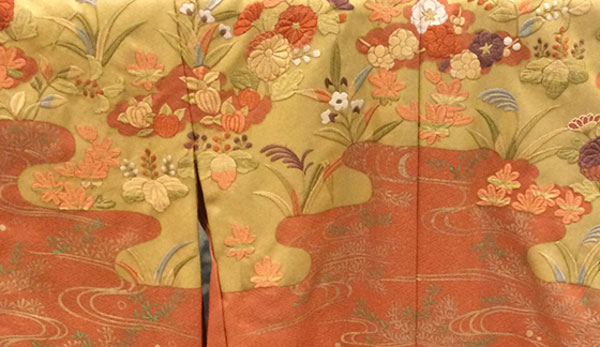
- Other textiles
- Kyoto
Kyo embroidery Kyo nui
Exquisite embroidery born from Kyoto's elegant culture
Japanese culture and beauty expressed in this rich and lustrous craft
Description
What is Kyo embroidery ?
Kyo Embroidery (called Kyo-nui) is produced in Kyoto, Kyoto prefecture. This graceful craft reflects the elegance of Kyoto's culture and requires meticulous skill. Artisans of this craft pursue absolute perfection and freely use costly silk, gold, and silver threads, for as many as thirty different techniques. This embroidery adorns mainly kimono, but a wide range of items are embroidered as well such as purses, bags, and shawls, and even heavy curtains and drapes. The color range is enormous with an array of about around two thousand shades. A standard kimono will use about twenty to thirty colors depending on the design. France also has a thriving embroidery culture similar to Kyoto, but French embroiderers use one predominant hand, whereas for Kyo Embroidery both hands are used to freely work the fabric from above and below, enabling a delicate artistic expression. During the Edo period (1603-1868), increasing exports of Kyo Embroidery led to great popularity overseas and fame as an icon of elegant Japanese expression. With its roots in the Heian period (794-1192), this craft is a beautiful product full of elegant Japanese culture.
History
The origin of Japanese embroidery is thought to date back to the Asuka period (530-710). Back then, embroidery was mainly found on Buddhist images, making them extremely valuable. In the Heian period, aristocrats in the capital city of Kyoto started wearing embroidered garments, and in the Imperial Court, a department called Oribe no Tsukasa was established to deal with the weaving and dyeing of kimono fabrics. This encouraged the considerable development of embroidery techniques in the Kyoto area. Kyo Embroidery was applied in many different ways, such as decoration on the layered kimono worn by court ladies or splendid costumes of Noh theater. During the Azuchi-Momoyama period (1573-1603), Kyo Embroidery was not only applied to the robes of Imperial Court nobles, but they also appeared on the kimono of samurai and their wives, and its use widely spread. During the Edo period, designs applying embroidery to the whole of a kosode kimono came into vogue as a reflection of the wealth of merchant classes, which was truly the peak of embroidery culture. In recent years, Kyo Embroidery is found on kimono accessories, kimono sashes, and interior items, keeping up with the modern life style.
Production Process
- 1. Drawing a design
An embroidery design is drawn with a pencil or sumi ink on paper. The design patterns cover a broad range from classical to modern original designs made by the craftsman.
- 2. Copying onto the fabric
The design is copied onto the material by shining a light through a glass sheet and tracing. Recently, silk-screen techniques are also used. The lines of the design fade away in the course of embroidering.
- 3. Color scheme
The threads and colors are selected according to the design. There are about two thousand types of Kyo Embroidery threads. As the color palette and taste differs depending on the workshop, each workshop dyes their own threads, creating a wide range of colors. The most suitable colors for the design are selected from these colors. Normally, twenty to thirty different shades are used for a kimono, but the final color selection is left up to the artisan. Experienced artisans even say that the threads call out and speak to them to guide them in the choice of shades and colors. These skills rely on years of experience and intuition.
- 4. Setting fabric on a frame
A large piece of fabric, with the sketch design, is set on a frame and stretched with wooden rods. It is important to get the tension right and not to warp the fabric. When embroidering fairly small items such as family crests on a kimono, a small embroidery frame is used. Next, with a special tool, the embroidery threads are twisted. This is a unique feature of Kyo embroidery, that reinforces the threads and raises the surface which plays a trick on the light and gives further depth to the rich colors. At the same time, light-catching sheens are created. This process is essential to ensure the exquisite expression of Kyo Embroidery.
- 5. Embroidery
The needles used for embroidery are handmade, with more than ten different styles commonly being used. Currently, there is only one company in Hiroshima producing these needles, so these needles are highly valued by the artisans. There are fifteen basic stitching techniques, but if fine stitching methods are also included, there are about one hundred and fifty stitching techniques. Originally, the work was divided according to stitching techniques, but this system no longer exists. Instead, each workshop pursues its own stitching styles and color palette to create original embroidery.
- 6. Finishing
To finish the piece, a light wash of glue is applied to the reverse side of the embroidered fabric to reinforce the overall embroidery and enhance the beauty.
Facility Information
Kyoto Museum of Crafts and Design

-
Address
-
Tel.+81-75-762-2670
-
ClosedDecember 29 to January 3
-
Business Hours9am to 5pm
-
Website































































































































































































































































































